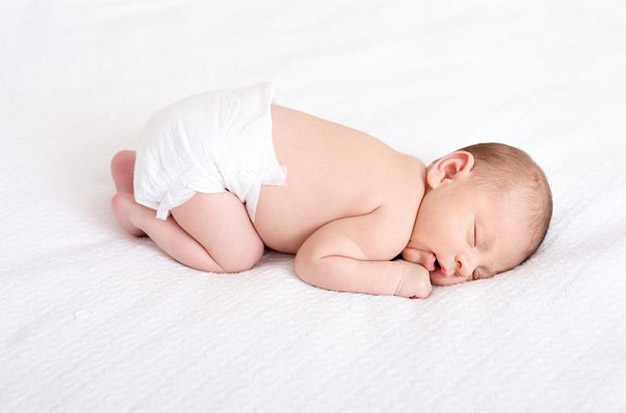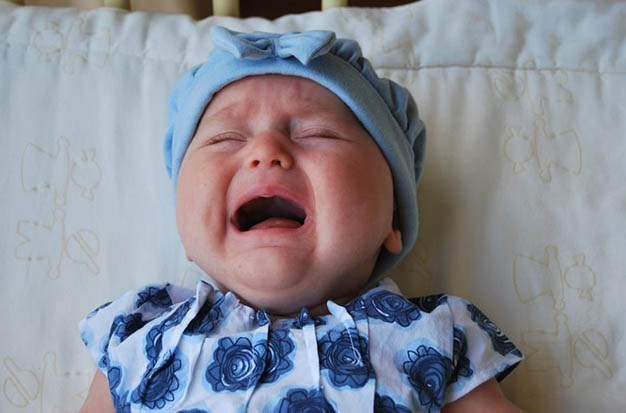Few words can strike fear and anxiety into the hearts of new parents like the mention of the word “colic” in the world of parenting.” Colic affects about 20% of babies and is a mystery to medical professionals. It is characterized by an excessive baby crying that isn’t brought on by any of the typical causes (i.e. a dirty diaper, an empty tummy, or a pacifier that’s dropped out of sight, never to be found again).
While colic doesn’t pose any immediate or long-term risks to the health of your baby, it can have an adverse effect on your health, raising the possibility of postpartum depression and causing feelings of exhaustion and frustration. But wait until you get a box of tissues of your own! Continue reading to learn how to comfort a colic baby with the best sleep positions and sleep-inducing strategies. This will help you ease your colic baby to sleep.
What Is Baby Colic?
Regarding what constitutes infant colic, there are varying views. A blockage in the intestines or intestinal gas was once thought to be the primary cause of colic’s severe, recurrent abdominal pain. But many medical professionals insist that colic can be characterized as episodes of intense, protracted fussiness or crying in a baby who is otherwise healthy.
Because babies often clench their muscles when they cry due to colic, colic can often be distinguished from normal infant crying. Similarly, your baby may cry more ferociously and inconsolably than usual if they are experiencing colic. Colic can start at any time, but it frequently does so at the same time of day or night and without a known cause.
What Is The Primary Cause Of Colic In Babies?
Additionally, a baby with colic might cry for extended periods of time for no apparent reason. There are numerous hypotheses about what might be a factor, though. So read on to learn more about the causes of colic in infants.
An Infection
An illness, like a viral infection, could be the reason why a child experiences colic. It’s also possible that your baby is allergic to something in your breast milk or formula. If your baby exhibits additional symptoms like fever, diarrhea, or vomiting, an infection is more likely to be to blame.
Overfeeding
Your baby may have been overfed, which can lead to colic. A baby who is overfed may swallow a lot of air, which can cause gas and tummy pain. Furthermore, if you breastfeed your baby, they might eat too quickly and swallow air. For signs that your baby is full, such as turning their head away from the breast or bottle, keep an eye out for them to avoid overfeeding.
Reflux
Reflux occurs when acid from the stomach flows back up into the esophagus. Your baby might cry as a result of this because it hurts. Your baby’s pain may be brought on by reflux if they frequently vomit or spit up. Furthermore, persistent ear infections might be a sign of reflux in your infant. If your baby fusses after eating, it’s also more likely to be the cause.
Food Allergies
Your baby may develop colic if you consume certain foods while breastfeeding. For instance, if you consume dairy products, your child might become lactose intolerant and experience pain and gas. Dairy, soy, wheat, eggs, peanuts, and tree nuts are a few of the common food allergens that can result in colic. Additionally, synthetic additives like flavorings and colorings could be to blame.
Milk-Protein Intolerance
Only a few infants are sensitive to or intolerant of the proteins found in cow’s milk. Inflammation and stomach pain may result from an immune response to this. Consult your doctor if you suspect your child may be allergic to or intolerant to milk proteins. They might advise switching to a formula with hydrolyzed protein or a hypoallergenic ingredient list.
Immature Digestive System
The most prevalent theory holds that gastrointestinal discomfort is what causes colic. As a result, they are unable to properly process some foods because their digestive system is still developing. As a result, they feel pain and other colic-related symptoms.
Why Do Babies Experience Worse Colic at Night?
Baby colic is more severe at night for a few reasons. First of all, babies are frequently more exhausted at night, which may make them more likely to cry. Second, there might be less noise and activity at night, which could amplify any cries or fussing. Last but not least, when parents are also trying to get some sleep at night, it can be more difficult for them to handle a crying baby. Fortunately, there are a few things parents can do to calm a colicky baby, like holding them close, gently rocking them, or playing calming music. Most infants will outgrow their colic and resume sleeping through the night with time and patience.
What Is The Best Sleeping Position For A Colicky Baby?

You might be interested in finding a solution if your baby suffers from colic. Changes in a baby’s sleeping pattern are one strategy that some parents find helpful. Some parents think that putting a colicky baby on their stomach is the best sleeping position for them. This claim is unsupported by science, but some parents find it to be true.
By preventing air from being swallowed by colicky infants and enhancing digestion, stomach/side sleeping may be beneficial. To lower the risk of SIDS, always put your baby to sleep on his or her back. To ease discomfort and lessen crying, have your colicky baby sleep on his or her side. According to a study, babies who slept on their sides experienced colic episodes that were shorter and less severe than those who slept on their backs.
Some parents discover that putting their infant on their stomach or side in a somewhat upright position helps to relieve the gas and pressure buildup that can aggravate colic pain. Others discover that it works best to recline while holding their infant close. Baby sleep positioners are typically not advised for colicky newborns.
To help with symptom relief, some medical professionals might advise putting your infant to sleep on his or her side or stomach. In the end, it’s critical to try various positions until you identify the one that is most comfortable for your baby. You can get more detailed advice and tips from your doctor or a lactation consultant if you’re having trouble putting your colicky baby to sleep.
How Can I Aid My Coughing Baby in Sleeping?
There are some things you can do to aid in putting your colicky baby to sleep. All babies should do these things, but colicky babies may find them particularly beneficial.
Watch Wake Windows
Newborns can only stay awake for a brief period of time before they must go back to sleep. You should have just enough time while they are awake to feed them and do a diaper change. Afterward, they are rested and prepared for bed.
A newborn baby can typically only remain awake for 30 to 60 minutes until they are 11 weeks old, so keep an eye out for sleepy cues from your baby. To prevent an overtired baby, get them ready for their upcoming nap.
The clock will be your friend if your baby has colic because they may not display the sleepy cues (or they may display them constantly). So that your baby can begin to feel predictable, try to stick to a simple newborn schedule for naps and feedings.
Use The 5 Strategies
The five simple steps (the “5 S’s”) were developed by Dr. Harvey Karp to calm and soothe fussy infants. These techniques can work for all babies, but can be especially helpful with babies who have colic:
Swaddle: Your baby will find great comfort in being wrapped in a tightly woven burrito. If you believe your child despises being swaddled, read on to learn the benefits and drawbacks of doing so.
Holding your infant on their side or stomach against your stomach can help calm them. In their crib, you can also support them on their side while you wait for them to calm down. (But always place them on their backs to help lower the risk of SIDS.
Put your baby to sleep with a white noise machine. A loud shushing noise can also be made while holding them close to you. However strange it may feel, colicky babies may find this to be very soothing.
Swing: Using your body, rock your infant from side to side.
Sucking fulfills a newborn’s non-nutritive need, so give them a pacifier.
Many of these soothing methods are assisted by Karp’s SNOO bassinet, reducing the need for constant baby movement. The SNOO is marketed as a 24-hour babysitter and claims to be able to increase both parents and children’s sleep!
Create an Environment that is Conducive for Sleeping
For babies to absorb during the day, there is a lot of stimulation! It can be both exciting and overwhelming for them to experience new sights, sounds, and smells, among other things, in this world.
When it’s time for sleep, make sure the baby’s sleeping area is peaceful and restful. That entails a pitch-black space with background white noise. Don’t worry about a nightlight; instead, use a good set of blackout curtains to completely block out the light in your nursery. To block out outside noises and create the peaceful sleep environment that babies require, use a white noise sound machine that runs continuously while your baby is sleeping.
Use the Shush-Pat
To help a baby with colic sleep, it’s too early to use one of our sleep-training techniques, but you can try Tracey Hogg’s “shush pat” method. With the shush pat, you put the baby in their crib, gently roll her to her side while you keep holding her, and then gently pat her back while making a shushing sound close to her ear. Your infant will find this comforting.
Prioritize Naps
A baby will have a harder time falling asleep if they are overtired because sleep breeds sleep. Additionally, they’ll have trouble staying asleep once they do fall asleep.
Do not assume that because your colicky baby missed all of their naps for the day, they will sleep better at night. The opposite will occur! You’ll likely be operating in survival mode if your baby actually has colic. Make sure to rule out any other problems before assuming your baby has colic because some parents confuse colic for overtiredness or reflux. Sometimes we simply have to put our babies to sleep in any way we can, whether it be in a baby carrier while being held, etc.

Conclusion
Try experimenting with various sleeping positions if your colicky baby is having trouble falling asleep. Some parents discover that the best position for their infant to sleep in is on their stomach or side, while others discover that the crib or bassinet is ideal. The best sleeping position for babies with colic seems to be on their left side, though this is not conclusive. Try putting your colicky baby to bed in this position and see if it helps if you are having trouble with them. Observe your child carefully, and if you have any worries, speak to your pediatrician. If you have any questions or comments, please leave them in the section below.



